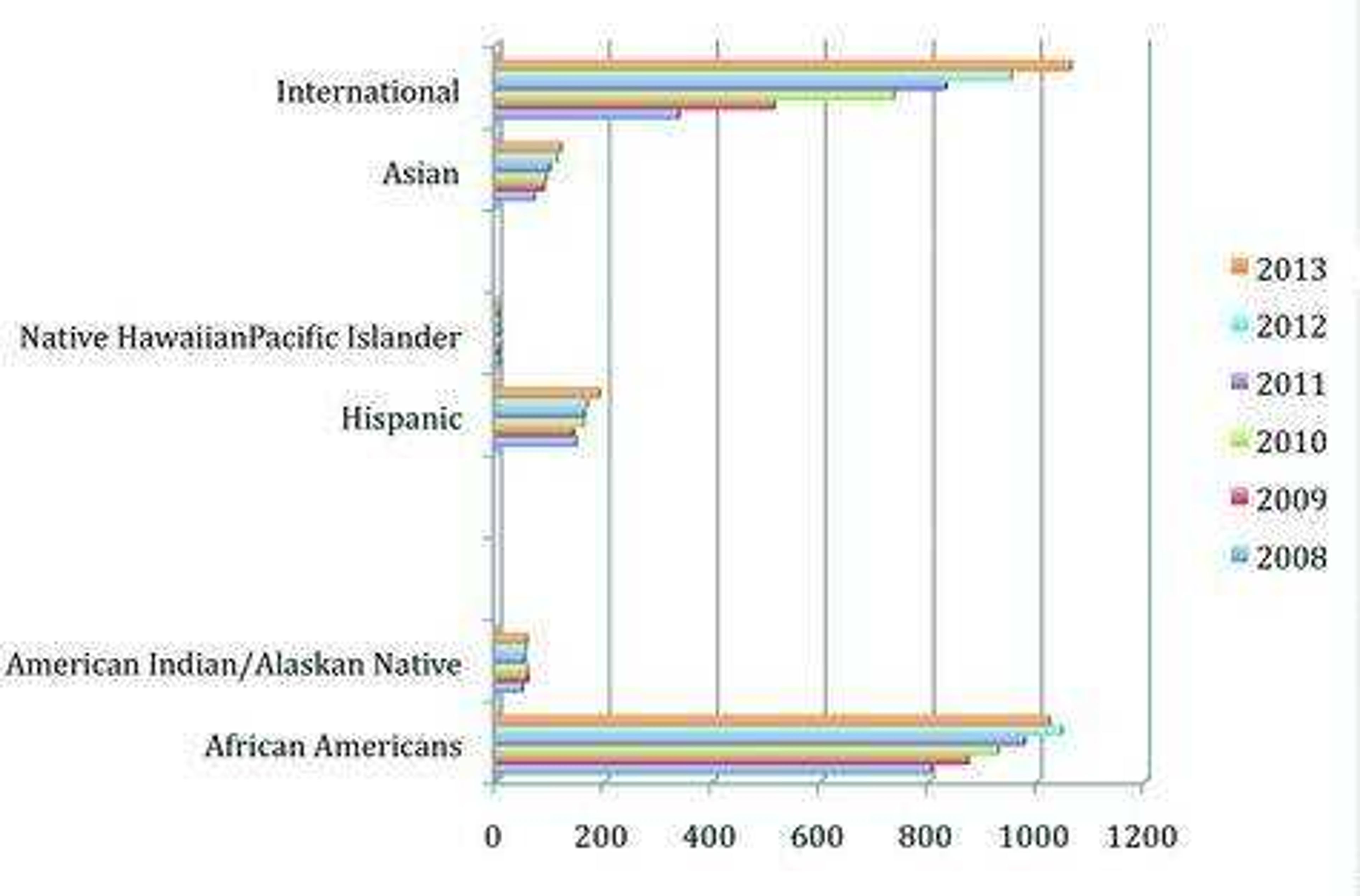Dr. Kenneth W. Dobbins has helped shape the various missions taken on by Southeast Missouri State University. From heading the initiative to create the River Campus, to establishing a program with the Center for Strategic and International Studies and even to the renovation and reopening of Academic Hall, Dobbins has realized many of the visions set forth by himself and the university. Another one of these visions that he has realized, but is still an initiative that will be continued on even after his retirement, is diversity growth.
In the fall of 2008 there were 10,814 undergraduate and graduate students enrolled at Southeast but only 1,281 of those students were minority students (African American, American Indian/Alaskan Native, Asian, International, Hispanic or Pacific Islander/Native Hawaiian), making only 12 percent of the entire student body minorities. Those numbers have since risen to a student population of 12,087 enrolled students with 2,449 of them being considered ethnic minorities, which is an 8 percent increase since 2008.
Dobbins said that growing diversity and making sure the minority population at Southeast is successful has been one of his missions as president, but he does not believe there has been one single thing that has been his biggest accomplishment in regards to diversity.
"When a student comes here that is not a majority, there are still opportunities for them to be successful, and we have minority mentoring programs, and if they are a first-generation college student like I am, you need to have something that can help them along and that is powerful and I think people see that we care," Dobbins said. "Our goal was to have the diversity of the student body reflect the diversity of the state of Missouri, and we have accomplished that over the last decade. We have gone [from] some 300 African-American students to over 1,000 and around 200 international students to 1,100 from over 35 different countries."
Dobbins attributes the growth in diversity on campus to programs that have been created and the team of people he has hired who work to help realize the idea of creating a diverse campus.
"We have hired a great person as executive director of international programs, Zahir Ahmed, and people like Trent Ball and others who are working to make sure that minority students are successful," Dobbins said.
Some programs and initiatives that have grown under Dobbins' presidency to promote diversity, racially and otherwise, include the President's Task Force on Diversity, the LGBTQ Resource Center, the TRIO Program and the creation of the coordinator of institutional equity and diversity position that has been taken on by Sonia Rucker this spring.
Dr. Debbie Below, the vice president for enrollment management and student success and dean of students, attributes the growth to Dobbins' and his commitment to finding faculty and staff members who support the vision of growing diversity.
"His most significant contribution to increasing diversity at Southeast is aligning our work with the mission of the university," Below said. "In our vision there are certain objectives, and we have said that diversity matters and that it is a critical component of a university education so that students will live and learn in a work environment that resembles that environment in which they'll live and work when they graduate. When you think about that, that means there are all kinds of strategic things that need to occur to realize that diversity, so you begin to invest in people that can reach out to communities and countries and start new academic programs that will attract a diverse student population."
While the enrollment of ethnic minority groups has risen, it is still below the national average. Below said that while it is true that Southeast may not be where it needs to be numbers-wise in regards to minority enrollment, it is taking steps to get to where it should be by taking part in national initiatives and bringing individuals to Southeast who can help realize the goals the university has set for diversity growth.
"The Complete College America initiative is a national initiative supported by the White House, the Bill and Melinda Gates Foundation and other private entities. The goal of the initiative is that by the year 2025, 60 percent of the American population will have a college certificate, associate or bachelor's degree. That number today is at about 40 percent, so we still have a tremendous amount of work to do. So we are where we are, but we aren't where we need to be," Below said. "When I started at the university in 2002, the university was already well on its way to sustainable growth and growth in diversity, and I asked him, 'How have you managed to maintain this sustained success as a president?' and his response was, 'I work hard to identify talented individuals who can help the university realize its goals and then I hire them and bring them to Southeast.' And so his single most important contribution might be assembling a leadership team and faculty and staff who align with the values of the institution. There is never just one thing that sustains this kind of growth, it has to be hundreds, if not thousands of little things -- luncheons, outreach, reaching out to parents, building a program, there's just a tremendous amount of initiatives."






